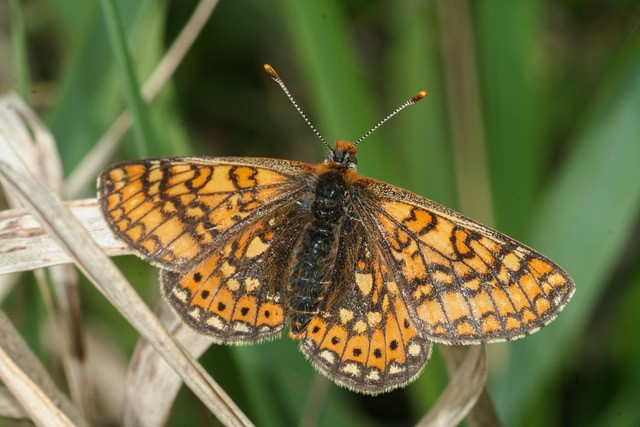Located in the heart of northern Europe, Luxembourg is not renowned for its good weather. And yet sub-Mediterranean insects are increasingly finding their way to the sun-soaked meadows and grassy hills of the country’s south.
“A good example is the praying mantis,” says Raoul Gerend, a primary school teacher and passionate entomologist. “It was seen sporadically in lux in the ‘50s and ‘60s. Then 10 years ago, it started to crop up everywhere in the south. I had a big adult female this time sitting on our doorstep.”
You’re absolutely immersed in it. You have to be so focused to get the information.
I meet Gerend on Roudebierg, a south-facing limestone hill that looks out over the town of Dudelange and the hospital where his children were born. The buzzing grassland site, which once belonged to steel giant Arbed, is today owned by natur&ëmwelt, a conservation group striving to preserve its biodiversity.
It is Gerend’s go-to place for the citizen science work he does identifying insect species for the national records. “In terms of spiders in 3 years I found 120 species. Beetles, it’s 400 already, moths also in the 400s. In the groups I’ve studied, I’ve identifed 1,300 species, not including wasps or flies.”

Entomologist Raoul Gerend is pictured at Roudebierg with a sweeping net for collecting insects on the surface of plants. MIKE ZENARI
Today Gerend focuses his attention on moths, not the prettiest of insects, but as he says “beauty is in the eye of the beholder”. On summer nights, when the temperature remains above 17°C, he spends hours on the hill with his light tent, identifying and documenting his findings. “It means getting away from your normal everyday life, your job,” he says of these trips. “You’re absolutely immersed in it. You have to be so focused to get the information.”
This year, nights like those have been few and far between. Luxembourg experienced its second-wettest July on record and data published this week reinforces the impression that . While most night-flying insects in this region will have evolved to cope with bad weather to a certain extent, the persistent cold and rain will certainly impact insect populations, reckons Gerend. “All those species are only there for a couple of weeks, most of them. They have to be able to find mates, reproduce, survive during this short span. If during this short span of time it rains most evenings it’s not so good,” Gerend explains.

The light tent Gerend uses to attract moths Raoul Gerend
More fragile species, like the marsh fritillary, once a commonly-found butterfly in Luxembourg which is today on the brink of extinction there, may struggle to recover. “Nowadays we’re confronted with isolated patches of habitat with smaller insular populations not in contact with other populations that tend to be genetically poorer. When they are confronted with something that stresses them, they might not be able to act in ways which are good for their survival,” says Gerend.
In addition to the weather, human intervention in the shape of intensive agricultural practices also endanger populations. “We don’t have meadows like this one [Roudebierg] in farmed countryside,” he says. Farms will often cut the grass up to five times per year to make sileage, disrupting insect life cycles. At the same time, the draining of fields and use of fertiliser make some soils too nutrient-rich for certain plants to survive. “You have a large number of species who only use one given species of plant to complete their life cycle,” the entomologist explains.

The Marsh Fritillary butterfly, pictured, was once a commonly-found butterfly in Luxembourg. Today it is on the brink of extinction Raoul Gerend
It means that there are species that were identified in Luxembourg between the ‘50s and ‘70s which are now rare or gone. Awareness-raising and knowledge sharing is one way the public can battle for biodiversity. For those with lawns, Gerend advises less frequent mowing and leaving patches untended for wild flowers to proliferate. People who do not have gardens, may find volunteering opportunities with natur&ëmwelt.
Read also

